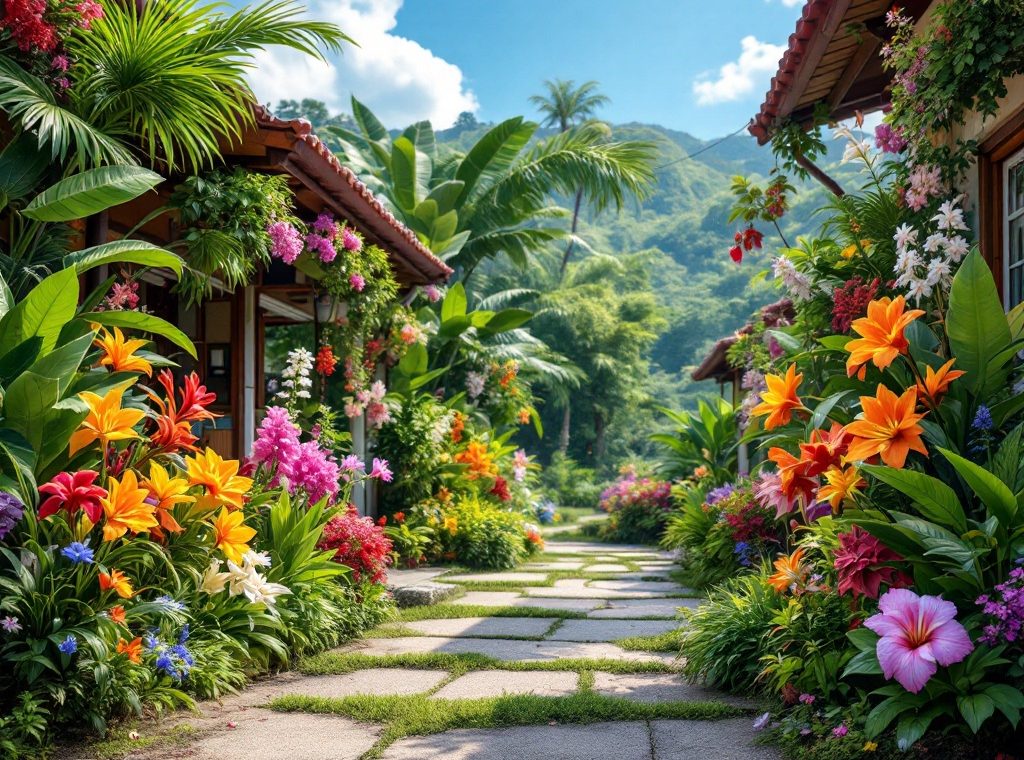Guide to Native Flowers in the Philippines
Discover the vibrant beauty and ecological importance of the Philippines’ native flowers! From the fragrant sampaguita, the national flower, to the rare waling-waling orchid, these blossoms are integral to the nation’s biodiversity and cultural heritage. Learn about their medicinal properties, ecological contributions, and how they enhance urban and rural landscapes. Explore practical tips for cultivating your own native flower garden and contribute to conservation efforts. Dive in and unearth the wonders of Philippine flora!
Important information

- The Philippines has diverse native flowers vital to its biodiversity, ecosystem, and cultural heritage, including the Sampaguita (national flower), Waling-Waling orchid, and Kalachuchi.
- These native flowers support local wildlife by providing food and habitat, especially for pollinators like bees and butterflies. They also contribute to a healthy environment by preventing soil erosion and conserving water.
- Native flowers are deeply rooted in Filipino culture, used in ceremonies, festivals, and traditional medicine. They also enhance the aesthetic appeal of urban and rural landscapes.
- Planting native flowers requires selecting species suitable for your garden’s conditions, using organic matter, and avoiding chemical fertilizers. Creating a pollinator-friendly environment is also beneficial.
- Habitat destruction, invasive species, and climate change threaten native Philippine plants. Citizen scientists and taxonomists play a crucial role in conservation efforts by monitoring populations, classifying species, and raising awareness.
Introduction to Native Flowers in the Philippines
The Philippines boasts a rich array of native flowers, contributing significantly to the nation’s biodiversity and playing a vital role in its ecosystem and cultural heritage. These blossoms are not merely ornamental; they are integral to the local ecology and even possess medicinal properties. Some of the remarkable flora include:
- sampaguita,
- waling-waling, and
- gumamela.
Iconic Native Flowers of the Philippines
The Philippines is home to a variety of unique and iconic flowers. Some of the most notable include the fragrant Sampaguita (Jasminum sambac), the vibrant Waling-Waling orchid (Vanda sanderiana), and the colorful Kalachuchi (Plumeria). Beyond these blossoms, the Kamagong tree (Diospyros blancoi) is prized for its dark wood. The sweet-smelling Ylang-Ylang (Cananga odorata) adds to the fragrant tapestry of the islands. The Banaba (Lagerstroemia speciosa) completes this remarkable collection of Philippine flora. These native plants are not only vital to the nation’s biodiversity, but they are also deeply woven into Filipino culture, playing essential roles in traditional ceremonies, perfumes, and medicines.
Sampaguita (Jasminum sambac): The National Flower
The Philippines’ national flower, the sampaguita (Jasminum sambac), features small, white blossoms with a powerful fragrance. Symbolizing purity and simplicity in Filipino culture, these delicate flowers are often woven into garlands or presented as offerings.
Waling-Waling (Vanda sanderiana): Queen of Philippine Orchids
The Waling-Waling (Vanda sanderiana), known as the “Queen of Philippine Orchids,” is a rare and exotic beauty. Its large, vibrant blooms make this national symbol a prized possession in the Philippines.
Kalachuchi (Plumeria): A Garden Favorite
The Kalachuchi (Plumeria) is a beloved garden plant, renowned for its stunning, fragrant flowers. These blossoms boast a vibrant color palette, ranging from pure white and bright yellow to soft pinks. In the Philippines, Kalachuchi flowers hold cultural significance, adorning gardens and temples, and are often woven into exquisite leis.
Kamagong (Diospyros blancoi): The Fragrant Flowering Tree
Kamagong (Diospyros blancoi) is known for its fragrant, delicate blossoms and exceptionally dark, durable wood. Its fruit is also edible. Furthermore, this tree holds cultural significance in the Philippines, symbolizing strength and resilience.
Ylang-Ylang (Cananga odorata): Perfume of the Philippines
Ylang-Ylang (Cananga odorata) is renowned for its intensely fragrant flowers, prized in perfumery and aromatherapy. The essential oils extracted from these blossoms offer calming and therapeutic properties, promoting relaxation and stress reduction.
Banaba (Lagerstroemia speciosa): Medicinal and Beautiful
The Banaba tree (*Lagerstroemia speciosa*) is known for its breathtaking lavender blooms, making it a beautiful addition to any garden. It also has a history in traditional medicine, with research suggesting its leaf extracts may help regulate blood sugar levels.
Ecological Contributions of Native Flowers
Philippine native flowers play a crucial role in the local ecosystem. They provide essential food and shelter for pollinators such as bees, butterflies, and birds. These flowers also help stabilize the soil, preventing erosion and conserving water. Their presence enhances biodiversity, supporting various animal species throughout the food web. Moreover, these native flowers are uniquely adapted to the Philippine climate and soil, contributing significantly to the ecological balance and promoting a healthy, resilient environment.
Supporting Local Wildlife and Pollinators
Native Philippine flowers play a crucial role in sustaining local wildlife. These vibrant blooms, including Lagundi, Alagaw, Aratilis, Kamatchile, Kapok, Duhat, Santol, and Tsaang Gubat, attract essential pollinators such as bees, butterflies, bats, and birds, contributing to a thriving and balanced ecosystem. These native plants not only enhance the natural beauty of the Philippines but also provide vital food sources and habitats for local fauna, supporting biodiversity.
Environmental Benefits of Native Plant Species
Native plants thrive in local climates, requiring less water, which helps conserve this vital resource. Their reduced need for fertilizer minimizes chemical runoff, leading to healthier soil and water.
Because they need less maintenance, like mowing and pruning, these plants also help reduce air pollution from landscaping equipment.
Native flowers, such as Banaba and Bani, attract essential pollinators like native bees and butterflies, boosting biodiversity and providing food and shelter for other wildlife.
Sociocultural and Aesthetic Benefits of Native Flowers
Native Philippine flowers are woven into the nation’s cultural tapestry, playing a vital role in religious ceremonies, festivals, and everyday life. They embody cultural values such as purity, love, and respect, while also enhancing the natural landscape’s beauty. Their vibrant colors and unique forms grace gardens and parks, enriching urban and rural environments and fostering a distinct sense of place. Beyond their aesthetic appeal, these flowers are uniquely adapted to the Philippine climate, making them ideal for sustainable landscaping and promoting ecological balance.
Role in Filipino Culture and Traditions
Native flowers are deeply embedded in Filipino culture, playing a key role in religious ceremonies, festivals, and celebrations. The sampaguita, for instance, is the national flower, symbolizing purity and simplicity, and is often used in religious offerings. Flowers are also integral to Filipino traditions, adorning decorations and gifts, and featuring prominently in art and literature. They represent the Philippines’ natural beauty and the people’s connection to their land.
Aesthetic Appeal in Urban and Rural Landscapes
Native Philippine flowers grace both urban and rural landscapes. Their vibrant hues and diverse forms transform streets and gardens into breathtaking displays. These blooms soften cityscapes, creating welcoming environments. In the countryside, they enhance the natural splendor.
Urban
Bougainvillea paints city walls with vivid color.
Rural
The delicate fragrance of Kalachuchi perfumes rural gardens.
Incorporating native flora into landscaping cultivates a deeper connection between people and their environment, fostering a strong sense of place.
Practical Guide to Planting Native Flowers
Cultivate a vibrant Philippine garden with native flower seeds like Sampaguita, Waling-Waling, Kalachuchi, Kamagong, Ylang-Ylang, or Banaba.
Select a species compatible with your garden’s specific soil, sunlight, and moisture levels.
Prepare the soil with organic matter, ensuring proper drainage.
Plant the seeds in clusters to replicate their natural growth patterns.
Regular watering is essential, but avoid chemical fertilizers.
Creating a pollinator-friendly habitat enhances growth, while simultaneously contributing to urban greening and supporting local biodiversity.
Seed Selection and Planting Tips
Source your seeds from reputable suppliers within the Philippines. Consider your local climate and soil type when selecting flowers. Native varieties, like the Waling-Waling orchid, are an excellent option. This particular orchid thrives in humid conditions and requires specific substrates, highlighting the importance of researching your chosen flower’s needs. Proper planting depth and spacing are crucial. A balanced watering routine is essential; avoid both over and underwatering. Here’s a step-by-step guide to planting your flower seeds:
Research your chosen flower’s needs. Understanding the specific requirements of your chosen flower variety is the first step towards successful cultivation.
Source your seeds from reputable suppliers within the Philippines. Quality seeds are more likely to germinate and grow into healthy plants.
Consider your local climate and soil type. Matching the flower’s needs to your local environment increases the chances of success.
Prepare your soil. Ensure it’s well-draining and enriched with the necessary nutrients.
Plant the seeds at the proper depth and spacing. Following recommended guidelines will give your seeds the best start.
Water consistently, avoiding over or underwatering. Maintaining a balanced watering routine is essential for healthy growth.
Urban Greening and Native Plant Integration
Native plant gardens provide vital habitats for urban wildlife. These gardens flourish with carefully selected native species that tolerate harsh city conditions. Moreover, using native plants enhances biodiversity and significantly improves the urban environment, making them a beneficial choice for everyone.
Conservation and Preservation Efforts
Native plants face serious threats, including habitat loss due to deforestation, urbanization, and agricultural expansion. Invasive species compete for resources, further endangering native flora. Illegal trade and unsustainable harvesting also contribute to the decline of vulnerable species. Climate change exacerbates these pressures with altered rainfall patterns and rising temperatures.
The Role of Citizen Scientists
Citizen scientists play a crucial role in monitoring plant populations, documenting their locations, and participating in conservation efforts.
The Importance of Taxonomists
Taxonomists play a vital role by identifying and classifying native flower species, providing essential information for conservation strategies.
Collaboration among scientists, local communities, and government agencies is key to successful conservation. This can include establishing protected areas, developing propagation programs, and launching public awareness campaigns. Despite these efforts, greater action is needed to safeguard native plants.
Challenges Faced by Native Plant Species
Habitat destruction, including deforestation, urbanization, and agricultural expansion, devastates native Philippine plants by disrupting delicate ecosystems.
Climate change alters temperature and rainfall patterns, impacting plant growth and survival.
Invasive species further compound the problem, competing with indigenous flora for vital resources.
These combined threats endanger the country’s unique biodiversity and its irreplaceable plant life.
Involvement of Citizen Scientists and Taxonomists
Citizen scientists play a crucial role by gathering data and conducting research. Taxonomy experts classify and name species, vital for accurate identification and conservation planning. Combined, these efforts significantly improve our understanding of Philippine native plants.











